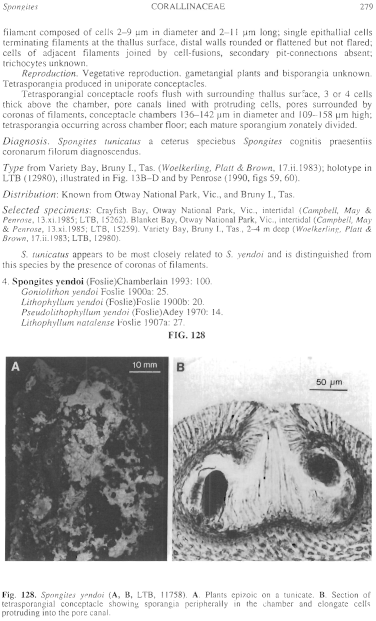|
|
|
|
|
|||||||||||
|
Electronic Flora of South Australia Species Fact Sheet
Phylum Rhodophyta – Class Florideophyceae – Order Corallinales – Family Corallinaceae – Subfamily Mastophoroideae
Synonyms
Goniolithon yendoi Foslie 1900a: 25.
Lithophyllum yendoi (Foslie) Foslie 1900b: 20.
Pseudolithophyllum yendoi (Foslie) Adey 1970: 14.
Lithophyllum natalense Foslie 1907a: 27.
Thallus encrusting or warty, epilithic and affixed by cell adhesion. Structure pseudoparenchymatous; organisation dorsiventral; construction monomerous, consisting of a single system of branched filaments that collectively contribute to a ventrally situated core, and a peripheral region where portions of core filaments or their derivatives curve outwards towards the thallus surface, each filament composed of cells 2–6 µm in diameter and 5–22 filT1 long; a single epithallial cell terminating filaments at the thallus surface, distal walls rounded or flattened but not flared; cells of adjacent filaments joined by cell-fusions, secondary pit-connections absent; trichocytes occurring at thallus surface, arranged in horizontal fields or singly, not becoming buried within thallus.
Reproduction: Vegetative reproduction, gametangial plants and bisporangia unknown. Tetrasporangia produced in uniporate conceptacles.
Tetrasporangial conceptacle roofs flush with surrounding thallus surface, 3–5 cells thick above the chamber, pore canals lined with protruding cells, pores lacking coronas of filaments, conceptacle chambers 164–232 µm in diameter and 109–185 µm high; tetrasporangia peripheral to a central columella, each mature sporangium zonately divided.
Type from Shimoda Harbour, Izul, Japan (K. Yendo, April 1899); lectotype in TRH (Yendo no. 66), designated by Foslie (1904).
Distribution: Japan; South Africa.
In southern Australia, known from Lorne, Vic.
Taxonomic notes: S. yendoi appears similar in vegetative portions of the thallus to Phymatolithon repandum and an examination of sections of tetrasporangial conceptacles is required to positively identify the species. The species occurs commonly in South Africa (Chamberlain 1993), and it is considered likely that with further examination of collections, the species also will be found to occur commonly in southern Australia.
References:
ADEY, W.H. (1970). A revision of the Foslie crustose coralline herbarium. K. norske Vidensk. Selsk. Skr. 1970 (1), 1–46.
CHAMBERLAIN, Y.M. (1993). Observations on the crustose coralline red alga Spongites yendoi (Foslie) comb. nov. in South Africa and its relationship to S. decipiens (Foslie) comb. nov. and Lithophyllum natalense Foslie. Phycologia 32, 100–115.
FOSLIE, M. (1900a). New or critical calcareous algae. K. norske Vidensk. Selsk. Skr. 1899(5), 1–34.
FOSLIE, M. (1900b). Remarks on Melobesieae in Herbarium Crouan. K. norske Vidensk. Selsk. Skr. 1899(7), 1–16.
FOSLIE, M. (1907a). Algologiske notiser. III. K. norske Vidensk. Selsk. Skr. 1906(8), 1–34.
The Marine Benthic Flora of Southern Australia Part IIIB complete list of references.
Publication:
Womersley, H.B.S. (28 June, 1996)
The Marine Benthic Flora of Southern Australia
Rhodophyta. Part IIIB. Gracilarialse, Rhodymeniales, Corallinales and Bonnemaisoniales
Reproduced with permission from The Marine Benthic Flora of Southern Australia Part IIIB 1996, by H.B.S. Womersley. Australian Biological Resources Study, Canberra. Copyright Commonwealth of Australia.
Illustration in Womersley Part IIIA, 1996: FIG. 128.

Figure 128 enlarge
Fig. 128. Spongites yendoi (A, B, LTB, 11758). A. Plants epizoic on a tunicate. B. Section of tetrasporangial conceptacle showing sporangia peripherally in the chamber and elongate cells protruding into the pore canal.

|
Email Contact: State Herbarium of South Australia |

|